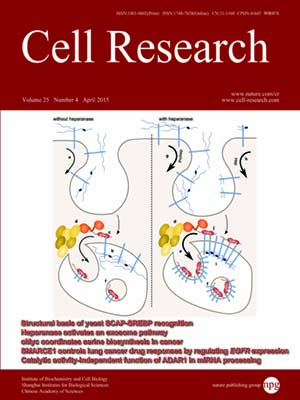
Volume 25, No 4, Apr 2015
ISSN: 1001-0602
EISSN: 1748-7838 2018
impact factor 17.848*
(Clarivate Analytics, 2019)
Volume 25 Issue 4, April 2015: 459-476
ORIGINAL ARTICLES
ADAR1 is required for differentiation and neural induction by regulating microRNA processing in a catalytically independent manner
Tian Chen1,*, Jian-Feng Xiang1,*, Shanshan Zhu2,*, Siye Chen1, Qing-Fei Yin1, Xiao-Ou Zhang2, Jun Zhang1, Hua Feng2, Rui Dong2, Xue-Jun Li3, Li Yang2,4 and Ling-Ling Chen1,4
1State Key Laboratory of Molecular Biology, Shanghai Key Laboratory of Molecular Andrology, Institute of Biochemistry and Cell Biology, Shanghai Institutes for Biological Sciences, Chinese Academy of Sciences, Shanghai 200031, China
2CAS Key Laboratory of Computational Biology, CAS Center for Excellence in Brain Science, CAS-MPG Partner Institute for Computational Biology, Shanghai Institutes for Biological Sciences, Chinese Academy of Sciences, Shanghai 200031, China
3Department of Neuroscience, University of Connecticut Stem Cell Institute, University of Connecticut Health Center, Farmington, CT 06030, USA
4School of Life Science and Technology, ShanghaiTech University, Shanghai 200031, China
Correspondence: Li Yang; Ling-Ling Chen(liyang@picb.ac.cn; linglingchen@sibcb.ac.cn)
Adenosine deaminases acting on RNA (ADARs) are involved in adenosine-to-inosine RNA editing and are implicated in development and diseases. Here we observed that ADAR1 deficiency in human embryonic stem cells (hESCs) significantly affected hESC differentiation and neural induction with widespread changes in mRNA and miRNA expression, including upregulation of self-renewal-related miRNAs, such as miR302s. Global editing analyses revealed that ADAR1 editing activity contributes little to the altered miRNA/mRNA expression in ADAR1-deficient hESCs upon neural induction. Genome-wide iCLIP studies identified that ADAR1 binds directly to pri-miRNAs to interfere with miRNA processing by acting as an RNA-binding protein. Importantly, aberrant expression of miRNAs and phenotypes observed in ADAR1-depleted hESCs upon neural differentiation could be reversed by an enzymatically inactive ADAR1 mutant, but not by the RNA-binding-null ADAR1 mutant. These findings reveal that ADAR1, but not its editing activity, is critical for hESC differentiation and neural induction by regulating miRNA biogenesis via direct RNA interaction.
10.1038/cr.2015.24
FULL TEXT | PDF
Browse 2346


